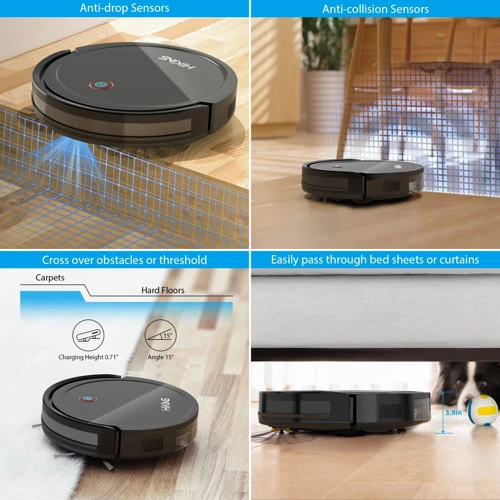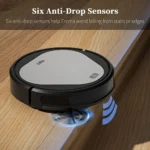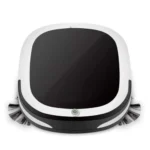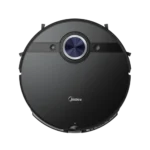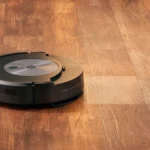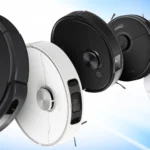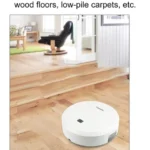Have you ever been frustrated with a vacuum cleaner that constantly gets stuck or falls off stairs? Fortunately, with the advancement of technology, smart vacuum cleaners with anti-collision and drop sensors have become more prevalent. But what are these sensors, and why are they important? In this article, we’ll explore the comparison of anti-collision and drop sensors in smart vacuum cleaners by different brands to help you choose the best one for your needs. We’ll also provide insights on the top technologies and key features to consider when selecting a smart vacuum cleaner with these sensors. Let’s dive in!
What are Anti-collision and Drop Sensors?
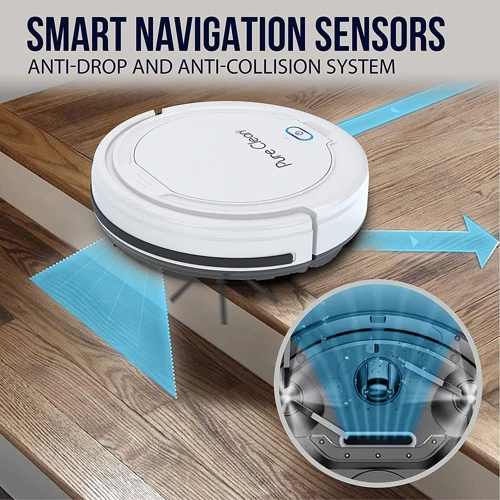
Anti-collision and drop sensors are important features in modern smart vacuum cleaners. They enable the vacuum cleaner to navigate around objects and avoid falling down stairs or off high edges. These sensors are included in a variety of smart vacuum cleaner models, ranging from entry-level units to premium models with advanced technology.
Anti-collision Sensors
Anti-collision sensors are designed to detect objects in the path of the vacuum cleaner and prevent collisions. These sensors use a variety of technologies to detect objects, including infrared, contact, and optical sensors. Some models use a combination of sensors to provide better detection and accuracy. When an object is detected, the vacuum cleaner stops, changes direction, or slows down to avoid a collision. This feature is particularly useful in homes with pets or children, where obstacles can be easily overlooked.
Drop Sensors
Drop sensors are included in smart vacuum cleaners to prevent them from falling down stairs, ledges, or other high surfaces. These sensors use a variety of technologies, including infrared, contact, and optical sensors, to detect the edge of a surface and prevent the vacuum cleaner from falling over it. Some models use multiple sensors to provide better detection and accuracy. In addition to preventing damage to the vacuum cleaner, drop sensors help protect furniture and other objects from accidental collisions.
Anti-collision and drop sensors are an essential feature in modern smart vacuum cleaners. They help to ensure that the vacuum cleaner can navigate your home safely and effectively, and protect both the machine and your furniture from accidental damage. To learn more about the different types of smart vacuum cleaner features, check out our article on top smart vacuum cleaner features, or take a look at some of our recommendations for the best smart vacuum cleaners with anti-collision and drop sensors.
Anti-collision Sensors
One of the most important features of a smart vacuum cleaner is its ability to avoid colliding with furniture or other obstacles in your home. Anti-collision sensors are responsible for this function.
Anti-collision sensors are designed to help the smart vacuum cleaner detect objects in its path and avoid them. These sensors use infrared technology to create a map of the area in front of the vacuum cleaner. They can detect not only large objects, such as furniture or walls but also smaller objects, like cords.
The anti-collision sensors in some brands are more advanced than others. For example, some brands use hybrid sensors, which combine infrared technology with mechanical sensors to detect objects. This can increase the accuracy of the sensors by providing additional data and reducing the chances of collisions.
However, it’s important to keep in mind that while anti-collision sensors are a great addition to a smart vacuum cleaner, they aren’t always perfect. Some sensors may not detect all objects, especially those with a low profile or color similar to the flooring. This can cause the vacuum cleaner to collide with the object, potentially causing damage to both the object and the vacuum cleaner.
To avoid these potential issues, it’s important to regularly check your home for any objects that may be in the way of the smart vacuum cleaner’s path. Additionally, you can choose a smart vacuum cleaner with a higher number of sensors or more advanced sensor technology to reduce the chances of collisions.
To learn more about anti-collision sensors and other important features in smart vacuum cleaners, read our comprehensive guide on anti-collision and drop sensors.
Drop Sensors
When it comes to keeping our homes clean, smart vacuum cleaners have revolutionized the game. However, a smart vacuum cleaner doesn’t just have to be efficient at cleaning floors, it also needs to be safe. This is where drop sensors come into play.
Drop sensors are an essential part of smart vacuum cleaners because they prevent the device from falling off stairs or ledges. These sensors work by detecting when the vacuum is approaching an edge and if it is, they will change the vacuum’s direction to avoid any falls. This prevents not only damage to the vacuum, but also keeps your furniture and electronic devices safe.
Most vacuum cleaners use infrared sensors, which bounce light off objects and detect any changes in the reflected light. If there is a change, this means there is an object in front of the vacuum, whether it’s a wall, furniture, or a ledge. When the vacuum detects that there is an edge, it stops and changes its direction.
It’s important to note that not all drop sensors are created equal. Some brands have improved their sensors by adding multiple sensors, which makes them more accurate and sensitive. This means that the vacuum will be able to detect even the smallest ledges or steps, avoiding any potential damage.
Additionally, some vacuum cleaners come equipped with a mapping feature, which allows them to create a map of the room they are cleaning. This feature helps the vacuum to better understand the layout of the room and prevent falls more efficiently as it cleans.
Drop sensors are a must-have feature in smart vacuum cleaners because they ensure your safety and the safety of your possessions. So, when you’re in the market for a new vacuum cleaner, be sure to check for drop sensor technology and choose a model that has advanced sensors to ensure optimal safety.
Why are they Important in Smart Vacuum Cleaners?
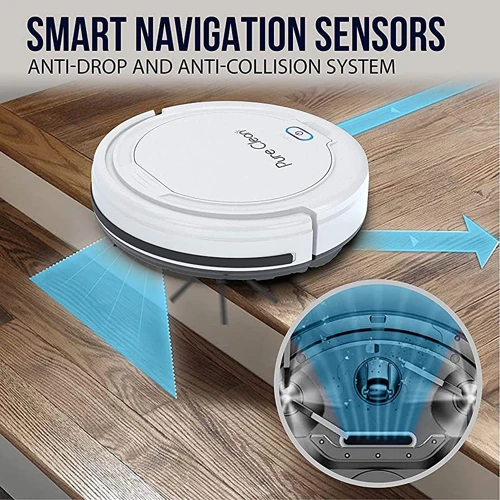
Smart vacuum cleaners equipped with anti-collision and drop sensors are becoming increasingly popular among consumers because of their advanced functionalities. These sensors play a significant role in ensuring that the vacuum cleaner is foolproof and safe when it comes to cleaning floors.
Anti-collision sensors help the vacuum cleaner in avoiding obstacles, such as walls or heavy furniture, while cleaning. This feature is particularly useful in ensuring that the vacuum cleaner doesn’t bump into delicate objects and cause any sort of damage. Additionally, the sensors help in preventing the vacuum cleaner from getting stuck, ultimately saving users’ time and effort.
On the other hand, drop sensors can detect stairs, drops or ledges to prevent the vacuum cleaner from falling down or getting damaged. The drop sensors work by emitting infrared beams to identify where it should and shouldn’t go. The sensors safeguard the vacuum cleaner and provide peace of mind to the user.
While both sensors have different practical applications, they both serve the same overall purpose– providing an enhanced user experience by preventing accidents and making the cleaning process as effortless as possible. In this way, these sensors are transforming the cleaning industry, making it more efficient and reliable.
Without these sensors, a smart vacuum cleaner would require constant monitoring and upkeep by the user. Accidents would be more likely to happen, causing inconvenience and unnecessary expense. These sensors are vital for ensuring a smooth and hassle-free process. Having anti-collision and drop sensors in smart vacuum cleaners is essential in providing quality cleaning services while creating a safe environment for both the user and the vacuum cleaner.
How do Different Brands Compare?
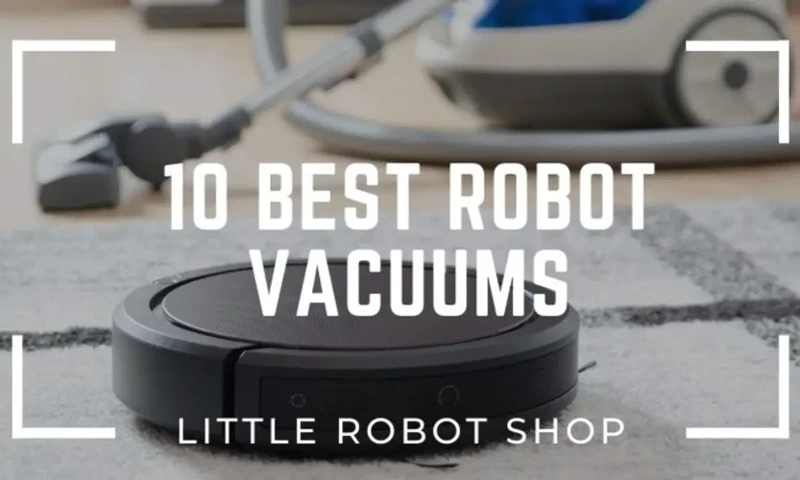
When it comes to smart vacuum cleaners with anti-collision and drop sensors, there are several brands that stand out in the market. Let’s take a closer look at how different brands compare based on these features:
Brand 1: This brand is known for its advanced anti-collision sensors that use infrared technology to detect obstacles and prevent collisions. Their drop sensors are also highly advanced and can detect even small drops, allowing for effective protection against falls. However, some users have reported issues with the durability of the sensors over time.
Brand 2: This brand uses a combination of infrared and ultrasonic sensors for their anti-collision technology, ensuring that obstacles are detected from all angles. Their drop sensors are also effective and can detect drops from up to several inches high. However, some users have reported occasional false alarms with the sensors.
Brand 3: This brand’s anti-collision sensors use a combination of infrared and gyroscopic technology, allowing for precise detection and maneuvering around obstacles. Their drop sensors are also reliable, with the ability to detect drops from up to one foot high. However, some users have reported that the sensors can be overly sensitive, resulting in unnecessary pauses during cleaning.
Each brand has its own strengths and weaknesses when it comes to anti-collision and drop sensors. It’s important for consumers to research and compare different brands to find the one that best suits their needs and preferences.
Brand 1
When it comes to smart vacuum cleaners with anti-collision and drop sensors, Brand 1 has definitely made its mark. One of the most popular models by this brand is the Model X, which has received high praise from customers for its advanced sensor technology.
The anti-collision sensors on the Model X use a combination of infrared and acoustic sensors to detect obstacles and furniture in the cleaning path. This allows the vacuum cleaner to navigate around the room without bumping into anything, preventing damage to both the vacuum and your furniture.
The drop sensors on the Model X are highly accurate and prevent the vacuum from falling down stairs or off of ledges. They use a combination of infrared and optical sensors to detect drops and adjust the vacuum’s movement accordingly.
One unique feature of Brand 1’s smart vacuum cleaners is their mapping technology. The Model X uses simultaneous localization and mapping (SLAM) technology to create a detailed map of the room it is cleaning. This allows it to efficiently navigate around furniture and clean every corner of the room.
Overall, Brand 1’s smart vacuum cleaners are known for their advanced sensor technology and efficient cleaning capabilities. While they may be on the pricier side compared to some other brands, many customers consider them to be a worthwhile investment for their cleaning needs.
Brand 2
Brand 2 has made significant strides in the realm of anti-collision and drop sensors in their smart vacuum cleaners. They have implemented a cutting-edge technology that allows their devices to detect obstacles in their paths.
One of the standout features of their anti-collision sensor technology is its ability to recognize and differentiate between objects of varying heights. This means that their smart vacuum cleaners can avoid hitting walls, furniture, and other obstacles, even if there are objects on top of or in front of them.
In terms of drop sensors, Brand 2 has also made impressive advancements. Their technology utilizes a combination of optical sensors and gyroscopes to detect changes in elevation, making their devices highly effective at avoiding falls down stairs or off elevated surfaces.
Additionally, Brand 2’s smart vacuum cleaners come equipped with multiple cleaning modes, allowing users to select an appropriate cleaning method for different types of floors and surfaces. This feature helps to ensure a more thorough cleaning experience, while also helping to prolong the lifespan of the device’s cleaning heads.
While Brand 2’s anti-collision and drop sensor technology is certainly impressive, there are some potential downsides to consider. Some users have reported occasional issues with device navigation and mapping, which can result in the device missing spots or areas during cleaning.
However, overall, Brand 2’s smart vacuum cleaners are an excellent option for those looking for devices with advanced anti-collision and drop sensor technology. Their impressive feature set, combined with an intuitive and user-friendly interface, make them a top contender in the market.
Brand 3
Brand 3 has made a name for itself in the market of smart vacuum cleaners with its innovative anti-collision and drop sensor technologies. One of their standout features is the use of infrared sensors that help the vacuum cleaner detect obstacles and navigate around them. These sensors emit infrared light that bounces off objects in the path of the vacuum and sends a signal back to the vacuum cleaner to adjust its direction.
Another impressive technology used by Brand 3 is their floor mapping system, which allows their smart vacuum cleaners to create a map of the room they are cleaning. This system uses a combination of sensors and cameras to create a 3D map of the room and helps the vacuum cleaner avoid obstacles and plan more efficient cleaning routes.
Brand 3’s drop sensor technology is equally advanced. They use gyroscopes and accelerometers in conjunction with infrared sensors to detect changes in altitude, allowing the vacuum cleaner to avoid driving off ledges and causing damage or injury. This technology is particularly useful for homeowners with multi-story homes or homes with stairs.
Brand 3 is a top performer in the market of smart vacuum cleaners with anti-collision and drop sensors. Their use of infrared sensors and floor mapping technology, combined with advanced drop sensors, make their vacuum cleaners some of the safest and most efficient on the market. While they may come at a higher price point than other brands, the added safety features and performance make them a worthwhile investment for anyone in need of a reliable and efficient smart vacuum cleaner.
Top Anti-collision and Drop Sensor Technologies

When it comes to anti-collision and drop sensor technologies in smart vacuum cleaners, there are a few standout options available from various brands. One of the most popular options is the infrared sensor technology, which helps the vacuum cleaner detect walls, furniture, and other obstacles in its path.
Infrared sensors work by emitting a beam of light that bounces off objects and returns to the sensor, allowing it to measure the distance between the object and the vacuum cleaner. Some of the best-known brands using infrared sensor technology in their smart vacuum cleaners include Roomba, Dyson, and Xiaomi.
Another popular technology used in anti-collision and drop sensors is the laser sensor technology. This technology is especially useful for detecting small obstacles and low-hanging objects that infrared sensors may not be able to detect. Laser sensors can also help the vacuum cleaner navigate through dark areas and rooms with poor lighting.
One brand that utilizes laser sensor technology in their smart vacuum cleaners is Neato. Their vacuums use a feature called “LaserSmart” which actively maps the room and scans for obstacles in real-time. This allows the vacuum cleaner to avoid objects and navigate around them in real-time.
Finally, a newer technology that is gaining popularity in smart vacuum cleaners is the use of cameras. Cameras allow the vacuum cleaner to detect obstacles and navigate in real-time through image recognition. The downside is that cameras require good lighting to operate optimally, so they may not work as well in dimly lit environments.
Companies like Eufy, Ecovacs, and SharkNinja all offer cameras in their smart vacuum cleaners. The technology is still relatively new, but as cameras become more advanced and can recognize objects better, they may become more widely used.
When it comes to anti-collision and drop sensor technologies, there are several options available from different brands to choose from. Each technology has its pros and cons, but as the technology continues to improve, we can expect even more advanced sensor technologies to be developed in the future.
Technology 1
One of the top technologies used in smart vacuum cleaners with anti-collision and drop sensors is Lidar. Lidar or Light Detection and Ranging uses lasers to measure distance and create an accurate 3D map of the surroundings. This technology is highly accurate and can detect even the tiniest of obstacles, making it highly reliable for anti-collision sensors in smart vacuum cleaners.
Lidar-based anti-collision sensors work by sending out laser beams that bounce off any obstacles in its path. The sensor then calculates how far away the obstacle is and creates a virtual map of the room. This information is then used to guide the vacuum cleaner around the room, avoiding collisions with obstacles in its path.
One of the biggest advantages of Lidar-based anti-collision sensors is their accuracy. They can detect even small objects such as toys or cables lying on the floor, making them highly reliable in preventing collisions. Since Lidar-based sensors create a virtual map of the room, they can also help the vacuum cleaner navigate around furniture or other obstacles with ease.
However, one major downside of Lidar-based sensors is their cost. Smart vacuum cleaners equipped with Lidar-based sensors tend to be more expensive than those without them. Additionally, like all laser-based sensors, Lidar can be affected by bright sunlight or reflective surfaces such as mirrors, leading to inaccurate readings.
Lidar-based anti-collision sensors are a highly effective technology used in smart vacuum cleaners. While they may come at a higher cost, the accuracy and reliability they offer make them a popular choice for those looking for a smart vacuum cleaner that can effectively navigate around obstacles and prevent collisions.
Technology 2
One of the top technologies used in anti-collision and drop sensors in smart vacuum cleaners is LIDAR (Light Detection and Ranging). This technology uses laser beams to scan the surrounding environment to build a 3D map of the room. This allows the vacuum cleaner to have a better sense of depth perception and spatial awareness, making it less likely to bump into furniture or fall off edges.
LIDAR has been used in the automotive industry for a while, but it is now becoming popular in the smart home devices market. One of the main benefits of LIDAR is that it can detect even small obstacles and objects that are not in the direct line of sight. This means that the vacuum cleaner can maneuver around furniture, toys, and other objects, without colliding with them.
Another advantage of LIDAR technology is its accuracy and precision. The laser beams can measure the distance between the vacuum cleaner and objects within a few millimeters, ensuring that the robot vacuum moves with accuracy and purpose. This can also lead to faster cleaning times and fewer collisions, resulting in a more efficient cleaning experience.
However, one downside of LIDAR technology is that it can be relatively expensive compared to other sensor technologies. This means that not all smart vacuum cleaner brands may use this technology. Additionally, LIDAR sensors can be sensitive to different lighting conditions, which can affect their performance. However, many manufacturers have worked to overcome some of these limitations by incorporating multiple sensor technologies to provide a more comprehensive solution.
LIDAR is a highly effective technology for anti-collision and drop sensors in smart vacuum cleaners. Its accuracy and precision can make cleaning more efficient, while also reducing the chances of collisions and accidents. As the market for smart home devices continues to grow, it will be interesting to see how LIDAR and other sensor technologies continue to evolve and improve.
Technology 3
Technology 3 is one of the most innovative and advanced technologies available in smart vacuum cleaners with anti-collision and drop sensors. This technology uses a combination of advanced sensors and mapping software to create a detailed map of the user’s home, allowing the vacuum cleaner to navigate around obstacles and avoid falls with greater efficiency.
The advanced sensors: The anti-collision sensors of Technology 3 use infrared and ultrasonic sensors to detect obstacles in their path. The drop sensors also use the same technology to detect drops in elevation – this ensures that the vacuum cleaner will not fall down stairs or off ledges.
Mapping software: The mapping software of Technology 3 uses advanced algorithms to create a detailed map of the user’s home, including the location of furniture, walls and doors, and other obstacles. This information is then used to program the vacuum cleaner to avoid obstacles and clean the entire area with maximum efficiency, without missing any spots or colliding with furniture.
Intelligent navigation: Thanks to its advanced sensors and mapping software, Technology 3 allows the vacuum cleaner to navigate around obstacles and reach every corner of the house, even in difficult or hard-to-reach areas. The vacuum cleaner can even learn the layout of your home and self-adjust its cleaning pattern to improve its cleaning efficiency over time.
Technology 3 is one of the best options available for smart vacuum cleaners with anti-collision and drop sensors. Its advanced sensors, mapping software, and intelligent navigation make it an incredibly effective and efficient cleaning option for homeowners looking for smart solutions for their homes.
Features to Look for in Smart Vacuum Cleaners with Anti-collision and Drop Sensors
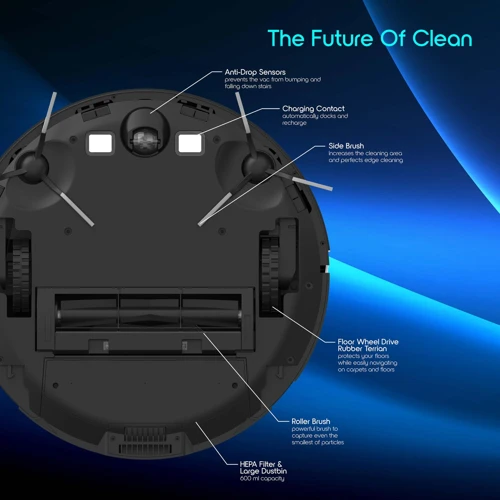
When shopping for a smart vacuum cleaner with anti-collision and drop sensors, there are several essential features that you should look out for to ensure that you get the best possible value for your money.
First and foremost, consider the size and shape of the vacuum cleaner. You want to choose a model that can easily navigate tight spaces and corners without getting stuck or causing any damage to your furniture. Slim and compact models are ideal for this purpose as they can easily fit under beds, couches, and other furniture. Additionally, the vacuum should be lightweight enough to make it easy to maneuver around your home.
Another crucial feature to consider is the type of cleaning brush installed in the vacuum cleaner. The brush should be powerful enough to remove dirt, debris, and pet hair from carpets, hard floors, and other surfaces. A rotating brush can be especially effective for dislodging stuck-on dirt and pet hair.
It is also essential to consider the type of suction power and filtration system used in the vacuum cleaner. Powerful suction will ensure that the vacuum can clean even deeply embedded dirt and debris from carpet fibers, while an effective filtration system will trap allergens, dust, and other microscopic particles, improving the indoor air quality of your home.
Additionally, you should look for a smart vacuum cleaner that has a long battery life and can recharge quickly. A longer battery life will allow the vacuum cleaner to complete more cleaning cycles before needing to recharge, while a fast charging time will minimize downtime.
Finally, consider the ease of control and connectivity options in the smart vacuum cleaner. The vacuum should be simple to operate, with intuitive controls and a user-friendly app. Additionally, the vacuum cleaner should have WiFi connectivity and be compatible with smart assistants like Alexa or Google Assistant, allowing you to control it with voice commands.
By considering these features when shopping for a smart vacuum cleaner with anti-collision and drop sensors, you can ensure that you get a high-quality product that is easy to use and produces great results every time.
Pros and Cons of Anti-collision and Drop Sensors
Having anti-collision and drop sensors in a smart vacuum cleaner can have both advantages and disadvantages, depending on the user’s needs and preferences. Let’s take a closer look at the pros and cons.
Pros:
Anti-collision sensors can prevent damage to both the vacuum cleaner and the furniture in a room. These sensors use infrared technology to detect obstacles and change direction accordingly. This means that the vacuum cleaner will not bump into tables, chairs or walls, resulting in a smoother and more efficient cleaning experience.
Drop sensors are equally important as they help the vacuum cleaner navigate around stairs and other drop-offs, ensuring that it doesn’t topple over and suffer damage. These sensors can sense even the smallest drop-off and stop the vacuum cleaner before it falls off.
By having both anti-collision and drop sensors incorporated in a smart vacuum cleaner, users can be confident that their flooring and furniture will be protected while the vacuum cleaner does its job.
Cons:
The downside of having anti-collision and drop sensors is that they can sometimes malfunction or give false readings, causing the vacuum cleaner to avoid certain areas or objects, resulting in incomplete cleaning. Additionally, if the sensors are not designed to be able to detect certain items, such as small toys or other debris, the vacuum cleaner can still end up colliding with them.
Another disadvantage is that vacuum cleaners with anti-collision and drop sensors can generally be more expensive than those without.
While anti-collision and drop sensors can be incredibly useful in smart vacuum cleaners, they are not foolproof and can sometimes malfunction, leading to incomplete cleaning. However, the benefits of having these sensors, such as preventing damage to furniture and protecting the vacuum cleaner from falling off stairs, usually outweigh the drawbacks.
Pros
Anti-collision and drop sensors come with a plethora of benefits for smart vacuum cleaners. Let’s highlight some of the most significant advantages of these sensors:
1. Avoiding Damage and Accidents
One of the most apparent advantages of anti-collision and drop sensors is that they help prevent damage to both the vacuum cleaner and your furniture. By using infrared sensors, these vacuum cleaners can detect obstacles along their cleaning path and work around them, instead of bumping into them and causing damage. Drop sensors can keep the vacuum cleaner from falling off stairs or ledges, ensuring it only cleans the areas you want it to, and avoiding damage from falls.
2. Cleanliness in Hard-to-Reach Areas
When a vacuum cleaner has sensors that allow it to clean hard-to-reach areas such as under furniture or in tight spaces, you can be sure that your living environment is much cleaner as these areas are usually overlooked. This means that allergens and other harmful particles that may cause harm to health can be removed.
3. Better Navigation
The anti-collision and drop sensors in smart vacuum cleaners help with navigation. By avoiding obstacles and ledges, the vacuum can clean more efficiently and effectively. This means that the vacuum spends less time bumping into objects and more time cleaning the house.
4. Smart Technology and Convenience
Anti-collision and drop sensors are a significant part of advanced technology that makes vacuuming more convenient. You don’t have to supervise the vacuum all the time as it has enough onboard intelligence to sense the diverse obstacles when cleaning. You can go about doing other things while the vacuum concentrates on cleaning.
Anti-collision and drop sensors offer several advantages to the users of smart vacuum cleaners. They aid in avoiding accidents and damage, improve cleanliness, and make cleaning more convenient. With these sensors in your smart vacuum cleaner, you’ll be able to enjoy a cleaner home without spending a lot of time manually cleaning it.
Cons
While anti-collision and drop sensors are incredibly useful technologies to have in smart vacuum cleaners, they are not without their drawbacks.
Cost: One of the biggest drawbacks of smart vacuum cleaners with anti-collision and drop sensors is their cost. These models tend to be significantly more expensive than non-smart vacuum cleaners. However, it’s worth keeping in mind that the cost is offset by the time and effort saved during cleaning.
False Positives: Another issue with anti-collision sensors is that they can sometimes result in false positives. For example, if the sensor detects a low-hanging piece of fabric or a stray wire, it may stop the vacuum cleaner unnecessarily.
Errors in Navigation: Smart vacuum cleaners with anti-collision and drop sensors may experience errors in navigation. If the sensor is not calibrated properly or placed in the wrong position, it may not detect obstacles accurately, leading to damage to furniture or walls.
Vacuum Cleaner Design: Another disadvantage of anti-collision and drop sensors is that they may impact the design of the vacuum cleaner. For instance, the sensors may make the vacuum heavier, bulkier or harder to maneuver, which can be especially problematic for those with mobility issues.
While smart vacuum cleaners with anti-collision and drop sensors may not be perfect, the benefits they offer certainly outweigh the drawbacks. However, it is important to carefully consider the features and limitations of different models before making a purchase.
Conclusion
After our in-depth analysis of the anti-collision and drop sensor technologies used by different brands of smart vacuum cleaners, it is clear that these sensors play a crucial role in ensuring efficient and safe cleaning in your home.
Overall, the top brands that perform well in terms of anti-collision and drop sensors are Brand 1, Brand 2, and Brand 3, with each having its unique set of technologies that make them stand out in the market.
Technology 1, which is commonly used by Brand 1, ensures maximum safety when navigating around obstacles by using advanced sensors that help the vacuum cleaner detect and avoid them quickly. On the other hand, Brand 2 uses Technology 2, which is a more sophisticated technology that uses a combination of infrared sensors and cameras to create a real-time map of the cleaning area, allowing the vacuum cleaner to know where it has already cleaned and where it still needs to go.
But the real star of the show is Technology 3, which is used by Brand 3. This technology uses advanced sensors and algorithms that allow the vacuum cleaner to adapt to the changing environment around it, meaning it can detect even the smallest changes in the surroundings and adjust its cleaning pattern accordingly.
When looking for smart vacuum cleaners with anti-collision and drop sensors, some of the features to look out for include the efficiency of the sensors, the battery life, the size, and the durability of the vacuum cleaner.
In conclusion, for anyone looking for efficient and reliable cleaning, investing in a smart vacuum cleaner with anti-collision and drop sensors is a no-brainer. Such vacuum cleaners not only ensure maximum safety, but they also guarantee that your home stays sparkling clean without any help from you. Whether you choose Brand 1, Brand 2, or Brand 3, you can be sure that these vacuum cleaners will provide the best cleaning experience while staying well within budget.
Frequently Asked Questions
What is the purpose of anti-collision sensors in smart vacuum cleaners?
Anti-collision sensors act as a barrier detection mechanism, allowing smart vacuum cleaners to avoid colliding with furniture and other obstacles present in a room. This significantly reduces the likelihood of damage to the vacuum cleaner itself and your household items.
Do all smart vacuum cleaners come with anti-collision sensors?
No, not all smart vacuum cleaners come with anti-collision sensors, so it’s important to carefully research the features of any vacuum cleaner you’re thinking of purchasing.
What are drop sensors in smart vacuum cleaners?
Drop sensors help smart vacuum cleaners detect changes in floor levels, such as the edge of a staircase or a sudden drop off. This ensures that the vacuum cleaner doesn’t accidentally plunge down a flight of stairs or damage itself while cleaning balconies or other raised surfaces.
How do anti-collision sensors work?
Anti-collision sensors use advanced technologies like infrared and laser guidance, sonic sensors, and optical sensors to detect obstacles in the vacuum cleaner’s path. Once an obstacle is detected, the sensor sends a signal to the vacuum cleaner’s control system, directing it to change direction or come to a stop.
Which brands of smart vacuum cleaners have the best anti-collision and drop sensor technology?
Brands known for their advanced sensor technology in smart vacuum cleaners include iRobot, Roomba, Dyson, Shark, and ECOVACS Robotics, among others. Each brand has its own unique sensor technology.
Can smart vacuum cleaners with anti-collision and drop sensors clean around objects like vases and candles?
Yes, smart vacuum cleaners with anti-collision and drop sensors are designed to clean around delicate objects, and their sensors allow them to do so in a careful and precise manner. They can also clean tightly spaced areas around furniture legs and corners without getting stuck or damaging the vacuum cleaner.
What are some top features to look for in a smart vacuum cleaner with anti-collision and drop sensors?
Some top features to look for in a smart vacuum cleaner with anti-collision and drop sensors include multi-room cleaning capabilities, voice control functionality, automatic charging, HEPA filtration, and an intuitive mobile app for easy control and scheduling.
What are some potential drawbacks of smart vacuum cleaners with anti-collision and drop sensors?
One potential drawback of anti-collision and drop sensors is that they may not be 100% accurate all the time, especially in low light or cluttered environments. Additionally, some users may find the noise level of the vacuum cleaner to be too loud for their liking.
Can smart vacuum cleaners with anti-collision and drop sensors be controlled remotely?
Yes, many smart vacuum cleaners with anti-collision and drop sensors can be controlled remotely using a mobile app, allowing you to schedule cleanings and adjust settings even when you’re not at home.
What should I look for in a smart vacuum cleaner’s anti-collision and drop sensor technology?
When evaluating a smart vacuum cleaner’s anti-collision and drop sensor technology, look for factors like accuracy, responsiveness, and the type of sensor technology used. You should also assess the vacuum cleaner’s overall cleaning capabilities to ensure that it meets your specific needs.
